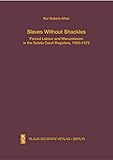Slaves Without Shackles : Forced Labour and Manumission in the Galata Court Registers, 1560-1572 / Nur Sobers-Khan.
Material type: TextSeries: Studien zur Sprache, Geschichte und Kultur der Turkvölker ; 20Publisher: Berlin ; Boston : De Gruyter, [2020]Copyright date: ©2020Description: 1 online resource (384 p.)Content type:
TextSeries: Studien zur Sprache, Geschichte und Kultur der Turkvölker ; 20Publisher: Berlin ; Boston : De Gruyter, [2020]Copyright date: ©2020Description: 1 online resource (384 p.)Content type: - 9783879974368
- 9783112209080
- 331.11734095609031 22/ger
- online - DeGruyter
- Issued also in print.
| Item type | Current library | Call number | URL | Status | Notes | Barcode | |
|---|---|---|---|---|---|---|---|
 eBook
eBook
|
Biblioteca "Angelicum" Pont. Univ. S.Tommaso d'Aquino Nuvola online | online - DeGruyter (Browse shelf(Opens below)) | Online access | Not for loan (Accesso limitato) | Accesso per gli utenti autorizzati / Access for authorized users | (dgr)9783112209080 |
Frontmatter -- Table of Contents -- List of Figures -- List of Tables -- List of Illustrations -- Acknowledgements -- A Note on Transliteration -- Chapter 1: Laying the Groundwork -- Chapter 2: The Corpus of Texts -- Chapter 3: Categorising the Origins of Slaves -- Chapter 4: The mukātaba Contract and Maritime Slave Labour -- Chapter 5: Identification or Subjugation? -- Chapter 6: Conclusion -- Appendix: Individual Slave Manumission Contracts -- Bibliography
restricted access online access with authorization star
http://purl.org/coar/access_right/c_16ec
This dissertation consists in a microhistorical study of the social and cultural context of slavery in the early modern Ottoman Empire and Eastern Mediterranean. Using a wide selection of primary sources in Arabic, Ottoman, Persian and various European languages, it examines the slave population recorded in the Ottoman shari'a court registers (1560-1572 ?AD) of Galata, a neighbourhood of Istanbul. Based on evidence from the court registers, the origins of the slaves, their rates of religious conversion, and the nature of slave labour in Galata are examined. A detailed analysis of the descriptions of slaves in the court registers and contemporary literature illuminates the cultural construct of slavery in sixteenth-century Istanbul, and it is argued that the contemporary discourses (legal, literary and pseudoscientific) surrounding slavery allow us to reconstruct the Ottoman articulation of difference and sixteenth-century Ottoman understandings of slavery. Furthermore, it is argued that the early modern Ottoman Empire encouraged the manumission and integration of skilled slaves into the urban social hierarchy; the capture and enslavement of skilled individuals, particularly in the context of sixteenth-century Ottoman maritime expansion, disposited as a method of increasing levels of Ottoman manpower and recruiting skilled labour into Ottoman elite households. In addition to presenting empirical findings concerning early modern slavery gathered from the court registers, this dissertation also presents the study of slavery as a framework for analysing the construction of identity in the early modern Mediterranean and argues for a new methodological approach to reading the Ottoman court registers.
Issued also in print.
Mode of access: Internet via World Wide Web.
In English.
Description based on online resource; title from PDF title page (publisher's Web site, viewed 27. Jan 2023)


